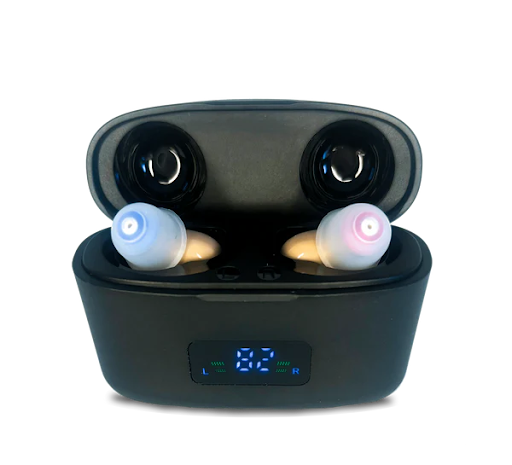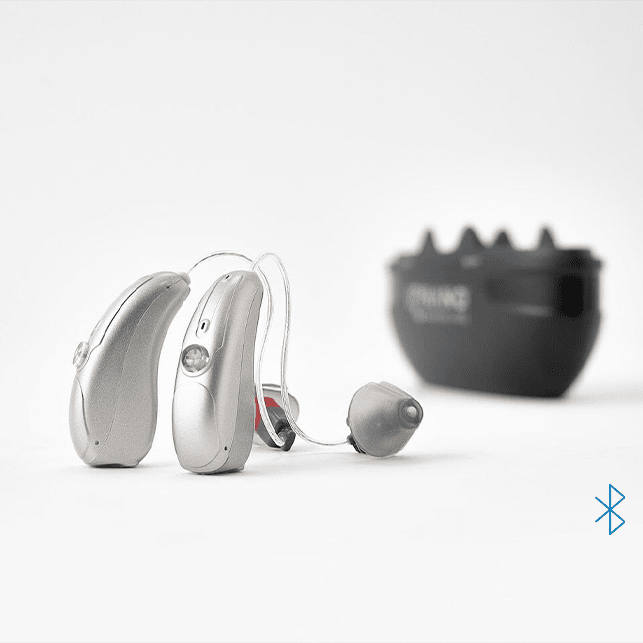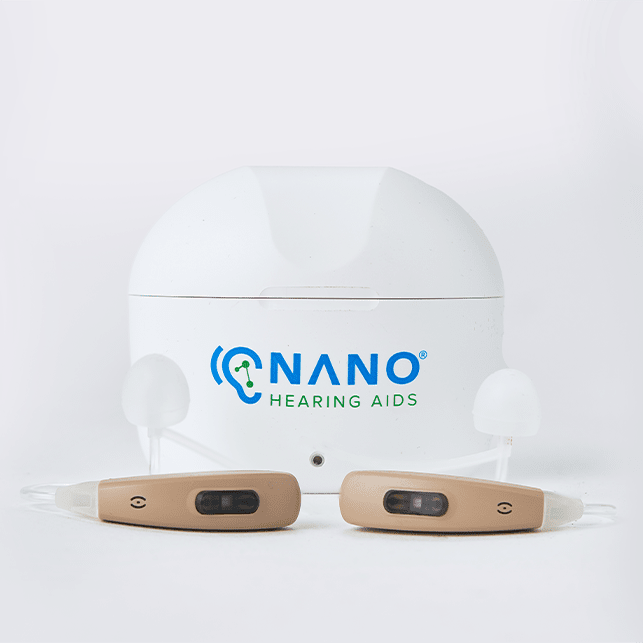Key Takeaways
- Sensorineural hearing loss (SNHL) is caused by damage to the inner ear or the auditory nerve.
- Common symptoms include difficulty understanding speech, especially in noisy environments, and a sense of muffled hearing.
- While SNHL is generally irreversible, there are effective treatments such as hearing aids, cochlear implants, and therapeutic interventions.
- Nano OTC hearing aids are a cost-effective and convenient option for adults with perceived mild to moderate hearing loss.
What is Sensorineural Hearing Loss?
Sensorineural hearing loss (SNHL) occurs when there's damage to the inner ear (cochlea) or to the nerve pathways from the inner ear to the brain. Unlike other types of hearing loss, SNHL is usually permanent because it involves damage to the nerves or hair cells, which do not regenerate.
Degrees of sensorineural hearing loss:
- Mild sensorineural hearing loss: Involves a decrease in hearing sensitivity ranging from 26 to 40 decibels.
- Moderate sensorineural hearing loss: Characterized by a reduction in hearing ability between 41 to 55 decibels.
- Severe sensorineural hearing loss: Refers to a significant loss of hearing, exceeding 71 decibels.
Nano Hearing Aids are FDA-registered, Class I devices. These OTC hearing aids are designed for individuals over 18 years of age with perceived mild to moderate hearing impairment. Nano won the Top ENT Solution Provider 2023, has 24/7 customer care, and has an affordable price compared to others.
Causes of Sensorineural Hearing Loss
- Aging Process: Hearing naturally diminishes over time, with age-related hearing loss being a common phenomenon.
- Loud Noise Exposure: Frequent encounters with high-volume sounds can damage hearing, affecting the inner ear's functionality.
- Viruses or Infections: Certain illnesses can lead to hearing loss, either through direct damage or complications arising from the infection.
- Head Injuries: Trauma to the head can impact hearing abilities, potentially damaging the auditory system.
- Ototoxic Medications: Some medications have side effects that can harm hearing, leading to temporary or permanent hearing loss.
- Genetic Factors: Hereditary traits can influence susceptibility to hearing loss, with some individuals genetically predisposed to auditory issues.
Symptoms of Sensorineural Hearing Loss
- Difficulty Understanding Speech: Struggling to comprehend words, particularly when there's background noise present.
- Muffled Hearing: Experiencing sounds as if they are distant or unclear, leading to distorted auditory perception.
- Tinnitus: Encountering a persistent ringing or buzzing in the ears, even in the absence of external sounds.
- High-Pitched Sound Issues: Facing challenges in hearing or distinguishing high-frequency sounds.
- Ear Fullness: A feeling of fullness in the ear.
Diagnosing Sensorineural Hearing Loss
Diagnosis starts with a thorough hearing evaluation by a hearing professional. This includes a physical examination of the ears and a series of hearing tests, such as audiometry, to assess the type and severity of hearing loss. Early diagnosis is essential for effective treatment and adapting to the condition.
Treatment Options for Sensorineural Hearing Loss
Although sensorineural hearing loss is typically irreversible, there are several treatment options available that can significantly improve hearing ability and overall quality of life. The choice of treatment depends on the severity of the hearing loss and the specific needs of the individual.
Hearing Aids: Features and Types
Hearing aids are the most common treatment for sensorineural hearing loss. They amplify sound to a level that the damaged ear can detect. Modern hearing aids come in various styles, each with its own set of features.
- Behind-the-ear (BTE) aids: These fit over the ear and are connected to a custom earpiece or earbud.
- Receiver-in-Canal (RIC) aids: These are behind the ear devices where the receiver or speaker is hard wired to sit in the ear canal, instead of in the housing of the hearing aid
- In-the-ear (ITE) aids: These are custom-made to fit within the outer ear.
- In-the-canal (ITC) aids: These are smaller and fit partly in the ear canal.
- Completely-in-canal (CIC) aids: These are nearly invisible as they fit completely in the ear canal.
It's important to determine the best type and fit for you and learn how to use and maintain the hearing aid properly. OTC hearing aids are an affordable option that does not require an audiologist.

Advanced Treatments: Cochlear Implants and Beyond
For those with severe or profound sensorineural hearing loss, cochlear implants may be an option. These devices bypass damaged parts of the ear and directly stimulate the auditory nerve. Cochlear implants can provide a sense of sound to people who are profoundly deaf or severely hard-of-hearing.
Another advanced treatment option is bone-anchored hearing systems. These devices transmit sound through the skull bone directly to the inner ear, providing another route for sound to reach the auditory system.
Research into gene therapy and hair cell regeneration also holds promise for future treatment possibilities.
Therapeutic Interventions and Rehabilitation
Beyond hearing devices, therapeutic interventions play a crucial role in managing sensorineural hearing loss. Auditory training and speech reading are techniques that can help individuals interpret sounds more effectively and understand speech better, even in noisy environments.
Rehabilitation programs can help individuals adapt to their hearing aids or cochlear implants and learn strategies for communicating more effectively.
Living with Sensorineural Hearing Loss
Adjusting to life with sensorineural hearing loss involves more than just using hearing aids or other devices. It's about creating an environment that supports communication. For example, using assistive listening devices in public spaces, ensuring good lighting for lip reading, and reducing background noise at home can all make a significant difference.
Support groups and counseling can also be beneficial, providing a space to share experiences and learn from others who are facing similar challenges.
Can Sensorineural Hearing Loss be Prevented?
While not all causes of sensorineural hearing loss can be prevented, there are steps one can take to minimize the risk:
- Utilize ear protection: In environments with elevated noise levels, like concerts or construction sites, wearing earplugs or earmuffs can significantly mitigate the sound intensity entering your ears.
- Limit exposure to loud sounds: Minimize the time spent around high-decibel noises, including those emanating from personal audio devices or industrial equipment, to safeguard your hearing.
- Schedule periodic hearing evaluations: Regularly assess your hearing, especially if you're exposed to workplace noise or have a genetic predisposition to hearing loss, to catch and address any issues early.
- Control underlying health issues: Actively manage conditions like diabetes or hypertension that can negatively impact your hearing health.
Nano OTC Hearing Aids for Perceived Mild to Moderate Hearing Loss

Over-the-counter (OTC) hearing aids, such as those offered by Nano, are an accessible option for those with perceived mild to moderate sensorineural hearing loss. These devices are designed to be used without the need for a custom fitting by a hearing professional, making them a cost-effective and convenient solution for many people.
For example, our rechargeable completely-in-canal model, First Ear Pro CIC, comes with customizable ear tips for a comfortable fit.
Frequently Asked Questions (FAQ)
What are the early signs of sensorineural hearing loss?
The early signs of sensorineural hearing loss can be subtle and easily overlooked. They often include difficulty understanding speech, particularly in noisy environments, frequently asking people to repeat themselves, and a tendency to increase the volume on devices like televisions and phones. Some may also experience tinnitus, which is a ringing or buzzing noise in the ears that others do not hear.
Can sensorineural hearing loss worsen over time?
Yes, sensorineural hearing loss can worsen over time, especially if the underlying cause, such as exposure to loud noise or an untreated medical condition, continues to affect the inner ear. Regular hearing evaluations are important to monitor any changes in hearing ability.
How can I communicate effectively with someone who has sensorineural hearing loss?
- Face the person directly and ensure your mouth is visible for lip-reading.
- Reduce background noise as much as possible.
- Speak clearly, at a moderate pace, and do not shout.
- Use gestures and facial expressions to give context to your words.
- Be patient and ready to repeat or rephrase if necessary.
Can sensorineural hearing loss be treated with surgery or medication?
Sensorineural hearing loss is typically not treatable with surgery or medication, as the condition often results from irreversible damage to the inner ear or auditory nerve. The primary treatments include hearing aids, cochlear implants, and other assistive devices, as well as therapeutic strategies to improve communication. In cases of severe and profound hearing loss, a cochlear implant may be an option. Cochlear implants require a very sophisticated surgery.






